Sheryn Dean: ‘Does New Zealand have too many hives and not enough bee food?’
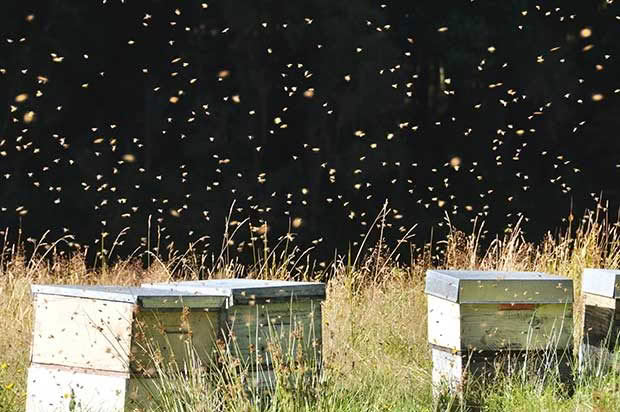
Is having your own hive of bees a good idea? Environmentally or economically? If that is the question, the answer may be surprising.
Words: Sheryn Dean
It wasn’t that long ago we were being told we had to save the bees. There was the varroa mite, the mysterious Colony Collapse Disorder wiping out entire hives, and the dreaded American Foulbrood disease (AFB). Our bees were in trouble, and with them a third of our food supply. Without bees, our fruits and vegetables would not get pollinated and we would all go hungry.
At best it seemed we should manage a hive and control the recently-arrived varroa mite (which has wiped out any bees living free). At the least, we should be planting bee-friendly plants so they have lots of food available.
While all true, like most messages, there is more to it than that. Some is more relevant internationally and some is about the very commercial business of making honey and money.
Are honey bees really in trouble?

Colony Collapse Disorder (CCD) is a name given to the unexplained depopulation of a hive. United States government figures have shown a 30 per cent reduction in honey bee colonies each year since 2007, and New Zealand had 9.7 per cent losses attributed to CCD in 2016.
Research is finding that multiple stressors such as malnutrition and compounding levels of combinations of chemicals are a probable cause of Colony Collapse Disorder. No surprises there.
The industry is catching on that stripping away the winter honey supply and replacing it with a sugar substitute is not nutritionally good for bees. Add in new diseases and pests, and a prevalence of pesticides, and the poor little honey bee is just not healthy enough to cope.
I believe bees in our ecosystem are like canaries in a coal mine and we should be taking note. If what is in our food source is negatively affecting a little bee, multiply it to a human scale and you need to wonder how it affects us.
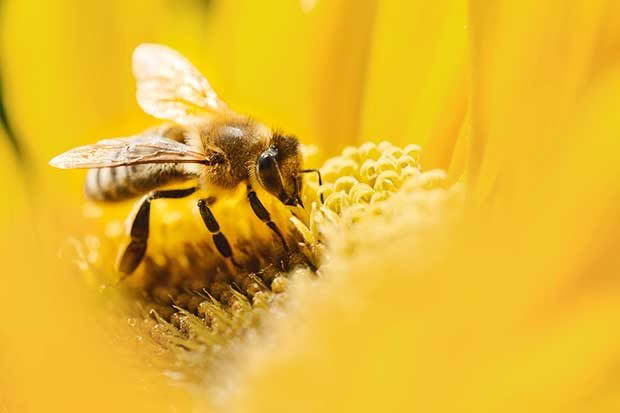
The total number of beehives in New Zealand has more than doubled in the last five years. We now have more hives per capita than any country in the world and, more seriously, are second in our density of hives per square kilometre.
The only areas with more bees per square kilometre are the massive almond orchards in California which import bees from as far away as Florida during the pollination season.
Saving the bees is not about being nice to cute little fuzzy parts of our ecosystem. It is big business. New Zealand exported $315 million worth of honey last year. Compare that to 10 years ago, when it was $30 million
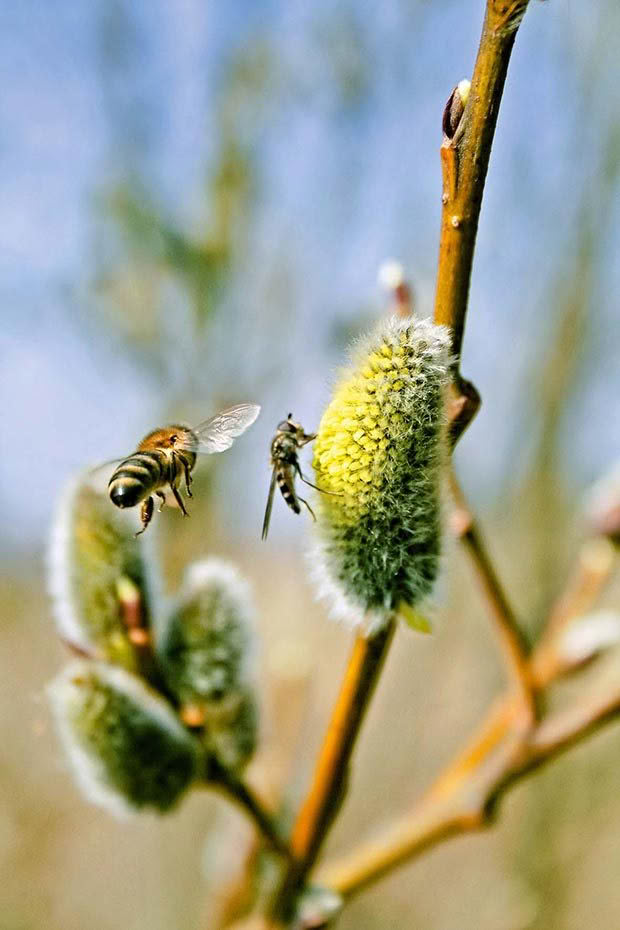
The 2015/16 season produced an estimated honey crop of 19,885 tonnes, a record crop, but only slightly higher than the previous year despite an additional 108,174 hives. The average hive yield of 29kg was lower than in recent years*.
Whether this density of bees is sustainable is starting to generate some debate.
*Statistics from Linda Newstrom-Lloyd, The New Zealand Beekeeper, and Apiculture NZ.
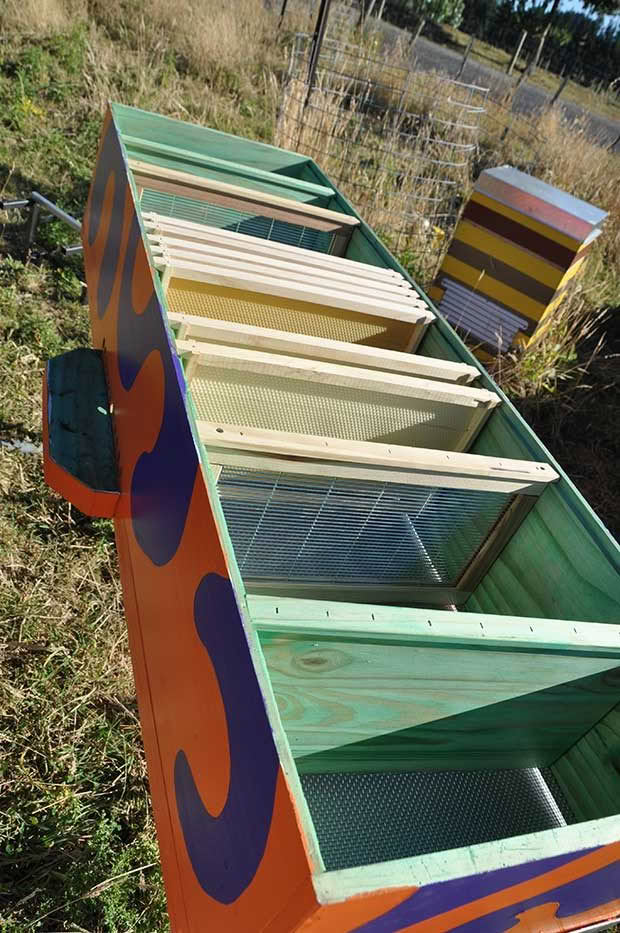
Sheryn’s hives.
WILL THE ABSENCE OF BEES AFFECT OUR FOOD SUPPLY?
Let me add a little qualification to this question. The absence of bees will seriously affect the world’s commercial food supply. The honey bee (Apis mellifera) is the only bee man can manipulate economically because:
• It lives in a large colony and can be housed and transported/
• Bees make a very saleable product, honey. These factors make it economically lucrative to do this.
• Beekeepers move hives into an area where pollination needs to be done, ie kiwifruit orchards, then away to another area once flowering is over. If bees were left to forage in a monoculture kiwifruit block all year – which is very low nutrition for a bee anyway – the bees would starve once the kiwifruit flowers have finished.
• Beekeepers move hives around to either get money for providing pollination services, or to a source like manuka to produce honey. This ensures the commercial food supply of most of our fruits and a lot of vegetables.
• It’s important to note bees prefer flowers that are easy to feed from, with a single row of petals in their favourite colours (blue, purple, white, yellow) as these are easiest to land on and retrieve nectar and pollen. Manuka is not their first choice if they have an option.
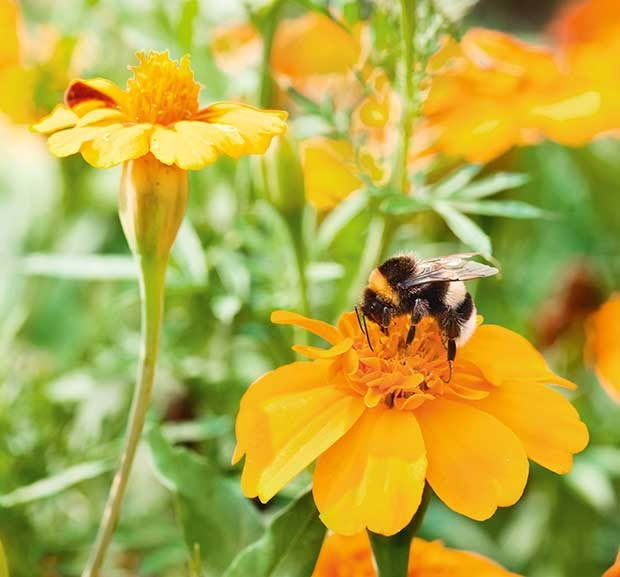
Honey bees are the most effective pollinators commercially as they are ‘floral constant’. This means once the bee scouts tell the hive about a good source (by dancing), the bees focus on that one species only. This is a positive commercially, but a negative in your home orchard if your lone apricot tree is being ignored for a more prolific crop of borage.
But pollination is not the life ambition of a bee. Worker honey bees need to forage enough food for the whole colony, which can be up to 60,000 strong.
They have to feed all the young brood, the queen, her drones (consorts whose sole job is to mate with the queen), and lay in enough honey for the winter, plus some for the human thief who steals their store.
Flowers provide food in return for the side effect of getting their male pollen transported to a (hopefully appropriate) stigma to fertilise the female ovule. It’s this act of pollination that initiates seeds, vegetables and fruit.
For an energy feed for the bee, and to stop her eating all the pollen, the plant provides nectar which is 80 per cent water with some complex sugars and cheaper for the plant to produce (using carbon rather than nitrogen). Nectar is sucked up into a second stomach and taken back to the hive to be regurgitated into honey.
One worker bee working flat-out for her entire life (until her wings wear out, or about 6-8 weeks in summer) will collect just one twelfth of a teaspoon of honey.
Pollen is full of vitamins and minerals and this is gathered for feeding to the bees when they are young. Dropping any onto receptive flower stigma (pollination) is a waste as far as the bee is concerned, but is a hazard of the job.
Thankfully each pollen granule contains between 100 to five million spores, so a bee only needs to drop one on the receptive stigma and voila, a seed is born.
THE BUMBLE BEES
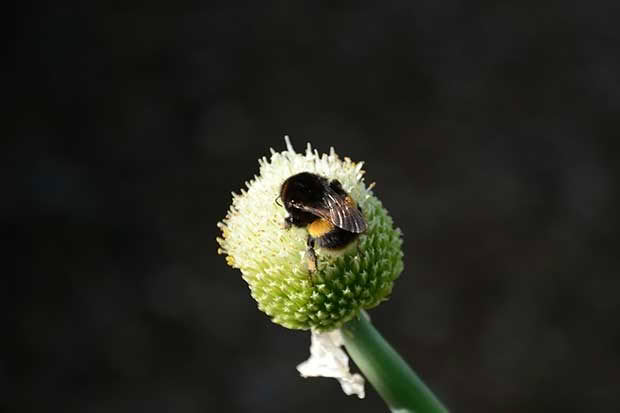
A bumblebee on a spring onion flower.
But the honey bee is not the only pollinator in town. Bumble bees were brought into New Zealand over 100 years ago, mainly because their long tongue is needed to get into the clover flower.
However, they are extremely effective general pollinators, and surpass the honey bee in a number of ways.
Firstly, they work longer and harder. These gentle giants of the bee species will fly at cooler temperatures (8°C compared to the honey bee’s 15°C starting temperature) and will still work on cloudy days and/or in wind speeds of up to 70km/h. Their larger hairy bodies can also carry quite a load.
They also ‘buzz’ – vibrate their body at a high frequency – to shake the pollen loose, which is more efficient for pollination and almost essential in some crops such as Solanaceous species (eg, potatoes, tomatoes, capsicums) and blueberries.
Another attribute is their ability to work under cover (something that can confuse the honey bee), which puts them in great demand in commercial greenhouses where tomatoes, capsicums, eggplants and strawberries are grown.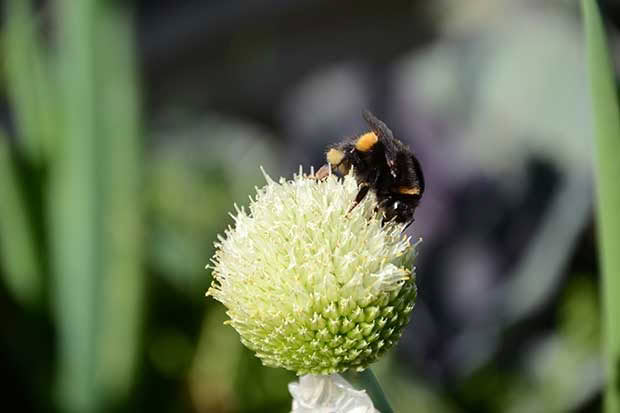
They are also not affected by the varroa mite.
A bumble bee colony is much smaller than that of the honey bee, usually only 150-200 workers. The bumble bee queens hibernate over winter in small cavities in the ground, emerging in spring to feed before finding a dry cavity in which to start a colony.
First, she lays a few eggs and tends to them, then as they hatch and take over some of the chores, she lays more and more eggs (for 3-8 weeks).
In mid-summer, old age starts to take its toll and the colony dies down except for new queens who are off gorging themselves in preparation for hibernation.
THE NATIVE BEES

Lleioproctus native bee.
Then there are the 32 species of native bee. These are less noticeable thanks to their black colouring, but they are very effective pollinators, as large in body as the honey bee and able to carry pollen loads of almost the same size.
Native bees are solitary in habit and don’t form colonies like the bumble and honey bee. Leioproctus and Hylaeinae sp. overwinter as fully-fed pre-pupae (the last larval or grub-like stage) in cells in nests, and hatch out in spring.
After mating, females construct new nests: Leioproctus in holes in the ground, Hylaeinae in hollow plant material. They spend the summer foraging and stocking up the nests until dying off in autumn, leaving another generation of pre-pupae behind.
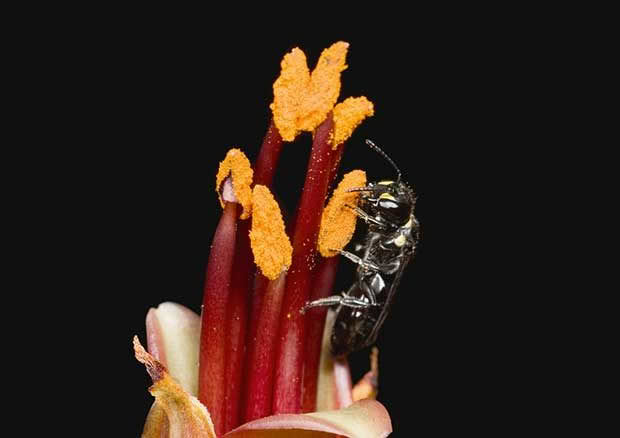
Hylaeus native bee.
Lasioglossum sp. over-winter as fertilised females in nests in the ground. Females become active as temperatures rise after mid-winter, and construct new nests from which males and females emerge within a few weeks.
After mating, the new females begin nesting, sometimes with several operating from the same nest. By autumn males and older females die off, while new, mated females remain in nests for the winter.
NZ also has thousands of species of tiny (friendly) wasps and birds, lizards, moths, butterflies, flies and other insects which also play a role in pollination. But all these ‘wild’ pollinators need food all year round, not just when our apple tree is in blossom.
The honey bee was bought into New Zealand in the early 1800s, along with most of our food-producing plants, and the focus has always been on them. Now that we have so many honey bees, a very serious question is what is the cost to our native bee and insect population as they compete for food?
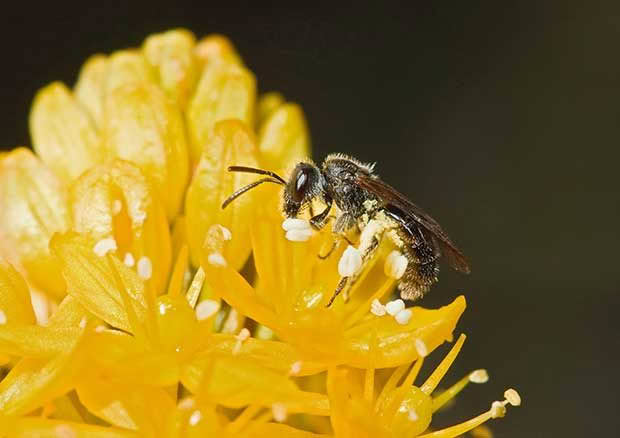
Nobody knows.
These other pollinators have never had a lot of attention. We don’t know their numbers before the honey bee arrived, how they compete for food, or how effective they are at pollinating our food.
They are not commercially important and no-one has cared enough to find out more about them.
MY EXPERIENCE WITH BEES
Pollination was never an issue in my diverse home orchard.
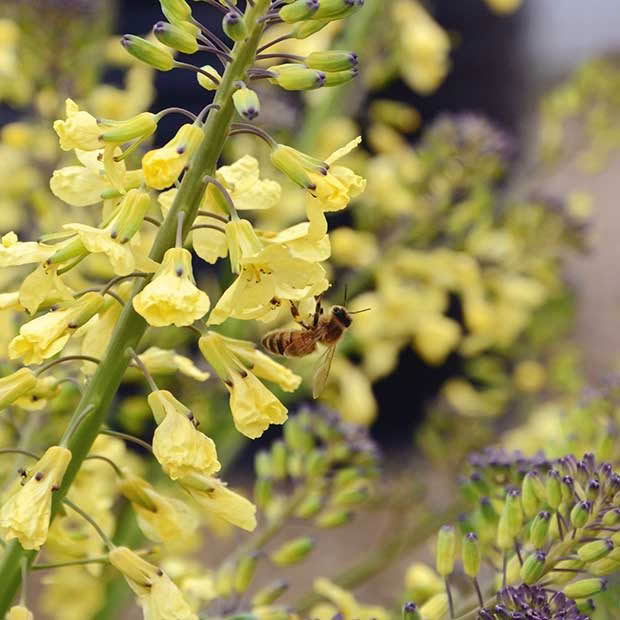
Thanks to understorey and companion planting, I have food available for beneficial insects most of the year. I don’t spray any pesticides (not even organic ones) and purposely leave areas of suitable habitat.
I often used to notice the little holes of the native bees in patches of bare ground. But despite some concentrated viewing, I have not yet seen a native bee entering or emerging from said holes, but the frequency of them was proof of a healthy population.
If that wasn’t enough, sometimes a beekeeper housed commercial hives on the neighbour’s farm and I am sure they came the kilometre or so to visit.
Then I jumped on the ‘Save the Bees’ bandwagon. I got my own hive. Despite trying to keep purchases to a minimum, I am now $1000 in debt to my sustainable source of honey.

Sheryn working with her hives.
I still have great pollination and now I also have honey to spare, but I don’t see many native bee holes.
Have I starved them out of existence? Do we really have enough food sources to support 50,000-200,000 honey bees per square kilometre, plus other indigenous insects and bees?
If optimum nutrition and reduction of chemicals is essential to honey bee health, we can presume the same goes for our native bees and other beneficial insects.
Our commercial mono-crops and cleared land don’t provide this, nor the habitats they need to survive, and this is where a lifestyle block or garden can play an important role.

WHY BEEKEEPERS FEED SUGAR (& NOT HONEY)
Beekeepers feed their bees a sugar solution to stimulate breeding.
After winter hibernation, they want the bee numbers to increase in time for the hive to take advantage of flowering.
If they left nature to take its course, the bees would not start reproducing until flowering starts, shortening their season and effectiveness.
Beekeepers feed sterile sugar solution as honey has the potential to transfer disease from one hive to another.
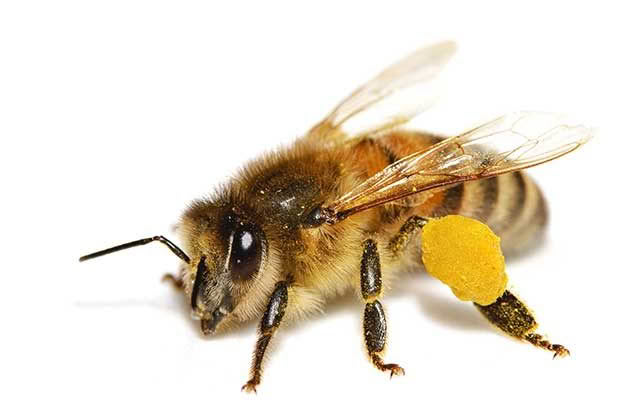
BEES DON’T WANT TO STING YOU
All female bees have a stinger but none deliberately set out to torment humans. Bees will only sting if trapped (say by clothing against the skin).
Stinging is usually fatal for the honey bee.
Her barbed sting gets stuck in our skin and unless we relax and let her slowly work herself loose (not the usual reaction to a sting), the sting rips out of her, taking part of her internal organs with it.
The native and bumble bee’s stinger is not barbed so theoretically they can sting numerous times (like a wasp) but stings from either are rare.
The native bees’ sting is apparently less painful the honey bees’.
5 WAYS TO BEE THOUGHTFUL
Planting plans need to take into consideration what is flowering and when for a constant supply.
1. From July-August when the bumblebee queens are foraging before mating.
2. Peaking over summer when the native bees and honey bees are in full swing.
3. Going through to autumn when everybody is building up reserves for winter.
4. For a list of bee-friendly plants and their flowering times, see the online resources below. There is a selection of native plants, flowers, orchard fruits and herbs we can choose to suit our landscaping.
5. 8Be careful that you don’t plant anything that is going to get out of control. The much-praised comfrey is a great plant with many uses, but once you have it, it’s never going away, so be careful where you plant it.
Resources:
NZ Tree Crops Association
Federated Farmers
Country | Number of hives | Hive per sq km of land area | Hives per capita
New Zealand: 700,000 | 2.658 | 0.1523
California, U.S.: 1,500,000 | 3.538 | 0.0387
United Kingdom: 274,000 | 1.134 | 0.0042
United States: 2,740,000 | 0.299 | 0.0085
Germany: 55,560 | 0.159 | 0.0007
Canada:* 700,000 |0.759 | n/a
Canada 700,000 | 0.076 | 0.0195
(total land area)
*at 10% land estimated to be available for apiculture.
DO THE MATHS
If the registered (managed by man) NZ bee population is 2.65 hives per kilometre, and you take out the Southern Alps and a lot of Auckland, we must be at a density of over three hives per kilometre around our homes.
At an average of 50,000 bees per hive, that is 150,000 bees looking for food every day in the square kilometre around your house. What is left for the locals?
Love this story? Subscribe now!
 This article first appeared in NZ Lifestyle Block Magazine.
This article first appeared in NZ Lifestyle Block Magazine.
